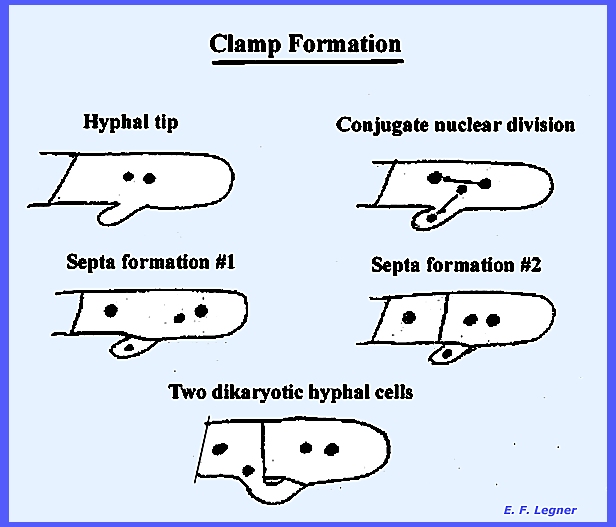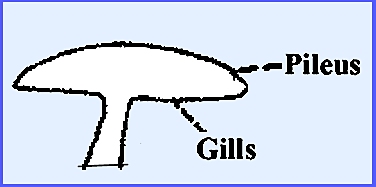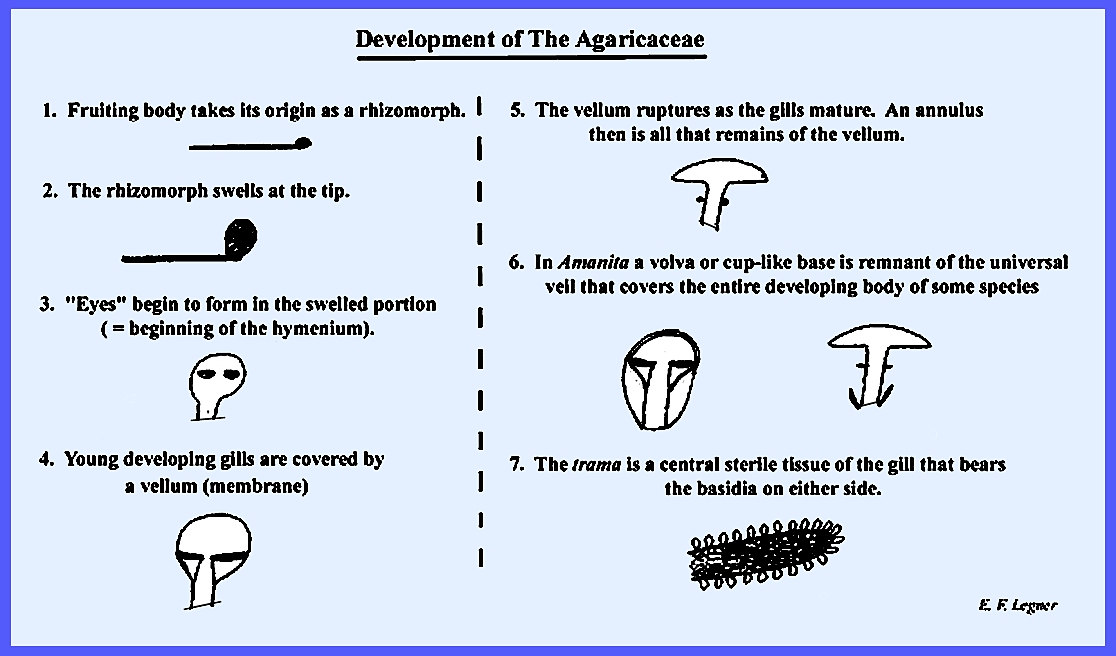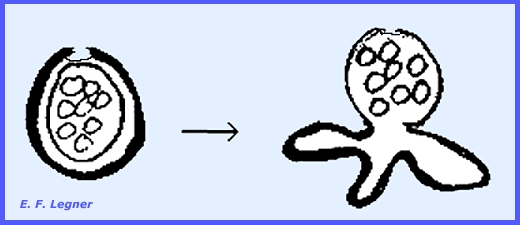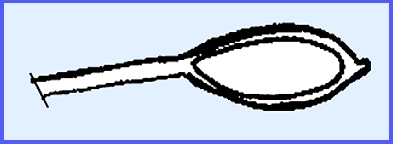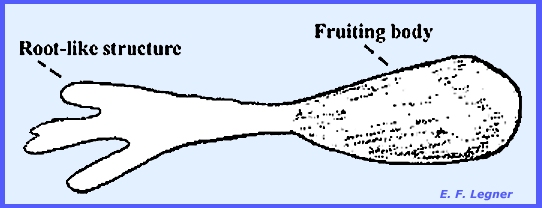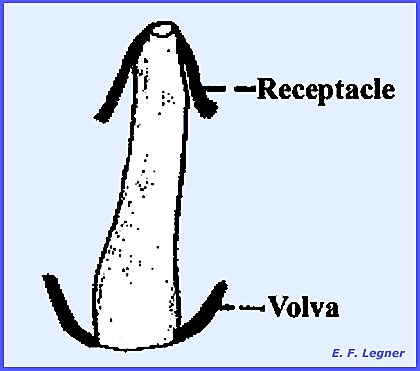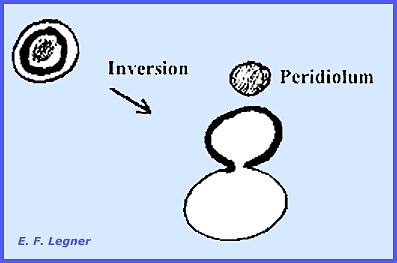File:
<basidiomycota2.htm> <Index to Mycology> Pooled References <Glossary> Site
Description <Navigate to
Home>
◄Introduction Fungi Imperfecti ►
Page 2
True Fungi (Eumycophyta) 1
Basidiomycota (Basidiomycetes, Basidiomycotina) --
Higher fungi
Sub-Classes: Homo-
& Holo-Basidiomycetes (Contact) CLICK on illustrations to enlarge:
Introduction The
Homobasidiomycetes is
a large group that includes most forms of well-known fungi. Due to their large size the fruiting
bodies of these fungi are familiar to those who have an interest in living
organisms. They are predominantly saprophytes and not one is obligately
parasitic. With rare exception these
forms produce conspicuous basidiocarps.Included are the mushrooms, shelf
fungi, coral
fungi, puffballs,
earthstars, stinkhorns
and bird's nest fungi. The basidia differ from the
Heterobasidiomycetes in being primarily non-septate (some rare
exceptions). They resemble asci, and during
their formation initially there are two nuclei which fuse. Four spores are formed apically on
sterigmata, which are in most cases forcibly discharged or the spores may be
sessile on the basidium.
Basidiospores NEVER BUD,
nor do they ever become septate. Two series are designated: Hymenomycetes and Gasteromycetes. The Hymenomycetes have a well-defined
hymenium of basidia, which are often accompanied by sterile structures and
cystidia. The hymenium is exposed
prior to maturation of spores. On the
other hand, in the Gasteromycetes there is usually no well-defined hymenium
and spores are never exposed until they are mature. Characteristics of
The Subclass Homobasidiomycetes The life cycles are similar in
pattern throughout this group of fungi.
There are no sexual structures and there is a very prominent
dikaryophase where the basidio9carps are built. Basidiospores do not bud, but they do give rise to a
monokaryotic mycelium. Many species are
heterothallic. Two monokaryotic
mycelia which are compatible must initiate the dikaryophase: Monokaryotic mycelium-1}
} = Dikaryotic mycelium Monokaryotic mycelium-2} The dikaryotic mycelium may
persist for over 100 years and is an absorptive dikaryophase. Over 95 percent of all hyphae are in the
dikaryotic condition. Clamp
connections are restricted to the dikaryotic mycelium and are most characteristic
of the Homobasidiomycetes.
Basidiocarps usually arise from rhizomorphs. The Dikaryophase is
initiated when the monokaryotic mycelium of one type contacts a monokaryotic
mycelium of another type. Hyphal
anastomosis forms the dikaryophase. The dikaryophase is spread to other cells of the mycelium
by a division of the two nuclei with the subsequent migration through septal
pores of the daughter nuclei. This
continues from cell to cell until the entire mycelial network is in the
dikaryophase. After the dikaryophase
has been reached the new growth will form clamps, which is also an indication
of the completion of the process. Oidia are produced in a sticky
matrix on small stalks, which branch out from the mycelium. They are conidial in function and also may
function in dikaryotization. Insects transfer the oidia to
another mycelium. If this mycelium is
monokaryotic the nucleus of the oidium will pass into the hyphal cell, which
sets up a dikaryophase. Oidia are
usually formed on a monokaryotic mycelium, but they may also be produced by a
dikaryotic mycelium, in which case they are still monokaryotic themselves. In the "Buller
Phenomenon" a dikaryotic
mycelium dikaryotizes a monokaryotic mycelium. Clamp Formation
occurs only in new growth (Fig. 401): There is predominantly a
tetrapolar type of compatibility: AB,
Ab, aB, ab AaBb
is the final combination required (only AB + ab and Ab + aB
are compatible. There is a Geographic
Race Phenomenon where all isolates are fertile with every other
isolate when the isolates are taken from separated geographic areas. A couple of meters are sufficient
separation in some cases. ---------------------------------- The
Series Hymenomycetes,
Order Agaricales is the largest in the
Basidiomycota and one of the largest in the entire fungal kingdom. It includes many of our most familiar
fleshy fungi. In all cases there is a
well-defined hymenium that consists of closely-packed basidia, often
accompanied by paraphyses and sometimes by larger sterile structures known as
"cystidia". The different families are separated
primarily on the form of the fructification and on the position in which the
hymenium is located. For example, the
covering of the surface of "gills", lining tubes, extending over
the surface of tooth-like projections, etc.
The families do intergrade to some extent. On the whole, however, the family lines are fairly sharp and
little difficulty is encountered in assigning most species to the proper
group. A majority of the Agaricales leads
a purely saprophytic existence, but a few are also aggressive parasites, and
some are involved in mycorrhizae.
Very few members of this large assemblage are known to have a conidial
stage. ---------------------------------- Characteristics of the Agaricales are shown by the
following six families: Exobasidiaceae is
the only family treated here that has no fruiting body. Species are parasitic on plants and form
no basidiocarp. There is a naked palisade-like hymenium on the host surface,
and great hypertrophy is induced, which is similar to that found in genus Taphrina
of the Ascomycetes.. Thelephoraceae
species are bracket-like, the hymenium being spread on the smooth
undersurface. One genus mimics a cup
fungus here, although the hymenium is on the outside of the cup. The basidiocarp varies from a very thin
and delicate basal weft of hyphae supporting the basidia to a well-developed
fruiting body. The most common type
of fructification is a tough, leathery or corky structure, which is
crust-like, shelf-like or upright with the hymenium always spread over a
smooth, even or undulating surface.
Most species of this family grow on wood. Clavariaceae
(Coral Fungi)
species have a fleshy or waxy texture.
There is an upright and often branching fruiting body with a
hymenium. The common name of "Coral
Fungi" derives from the
beautiful compact branching form exhibited by many species. However, some are less spectacular, having
only simple club-shaped or slender columnar basidiocarps. The texture of these fructifications is
generally fleshy or waxy, and most of them tend to decay rapidly. The hymenium extends over the whole
surface of the fructification except at the base, which may be considered a
poorly differentiated stalk. Old
decayed wood is a common habitat of most species of Clavaria, the most
important genus in the family. Hydnaceae (Tooth Fungi)
have downward projecting "teeth."
Some mimic mushrooms, but they have teeth instead of gills or
pores. These "teeth" are
usually projected downward. The
hymenium forms a coating over the teeth.
A very great range is found in the form and texture of the
fructifications. Polyporaceae (Pore Fungi)
have species where the basidia line the tubes or pores. This is the most important of
wood-destroying fungi. In the genus Fomes
the perennial fruiting body adds a new layer of pores below the old one every
year. The name "Pore
Fungi" comes from the
fact that their hymenia line the numerous tubes or pores that are found on
the underside of the fructification.
The basidiocarps are mostly corky or woody in texture and usually
bracket-like in form, although some are resupinate and others consist of a
stalk and pileus. The great capacity
of members of this family to disintegrate wood makes them both highly
beneficial and highly damaging organisms.
A few species attack living tissue in standing trees. Boletaceae
species were once included in the Polyporaceae as they have a stalk and a cap
similar to a gill fungus. Beneath the
cap is found a layer of tubes that is easily pulled away from the rest of the
fructification. Fruiting bodies of
most species occur on the ground in forests.
Many species are mycorrhizal fungi and certain species are regularly
found only beneath certain kinds of trees, especially the conifers. In autumn they occur all over North
America from sea level to over 3,000 meters in moist mountain areas. Most species are edible and generally safe
to harvest. Drying enhances their
flavor when added to stews, soups, etc.
In America the cap is usually covered by a skin that is removed for
consumption, while in humid areas of Central Europe this skin is not
pronounced. Agaricaceae (Gill Fungi)
There are over 100 genera and 6,100 species known, many of which have an
excellent flavor. A few are
aggressive parasites on seed plants, some are undoubtedly mycorrhizal but
most appear to be saprophytes on vegetable matter in the field and on the
forest floor. A few species may be
found on wood. The basidiocarp
usually consists of a stalk and cap (pileus) and is usually very fleshy in
texture and hence decomposes rapidly.
However, a few members of the family have more durable, leathery
fructifications, and a few have basidiocarps that are bracket-like in
form. In all cases there are
radiating gills or "lamellae" on the underside of the
fructification, and the hymenium spreads almost evenly over the gill surface. A Key to some of the common genera of Agaricaceae is presented in Plate 232. The "Field
Mushroom," Agaricus
campestris has
been cultivated for over 260 years and which today forms the basis for the
substantial mushroom-growing industry.
In the search for wild mushrooms used for human consumption the genus Amanita is of special concern, for this
includes several species whose fruiting bodies are deadly poisonous. The basidia are borne on radiating
gills. Paraphyses and cystidea occur
on the hymenium together with the basidia.
The cystidea play a part in spreading the gills initially. The Life Cycle of the Agaricaceae
is diagrammed as follows in Fig 404: Further details in the
developmental cycle of the Agaricaceae may be viewed in Fig. 403 as
follows: ---------------------------------- Please see following plates for Life
Cycles and Structural characteristics in the Agaricales: Basidiomycota: Homobasidiomycetes: Agaricales Plate
163 = Oidiophore: Coprinus lagopus. Plate
179 = Hymenium of a polypore. Plate
178 = Structures of Exobasidium vaccinii. Plate 180 = Agaricaceae (Agaricus spp.)
Basidiocarp. Plate 181 = Agaricaceae (Amanita spp.)
Basidiocarp Plate
182 = Trama:
With & without sphaerocysts. Plate 232 = Key to Genera Of The Agaricaceae Plate 233 = Example Structures: Agaricales: Polyporaceae & Boletaceae Plate 234 = Example Structures: Agaricales: Hydnaceae & Clavariaceae Plate 235 = Example Structures: Agaricales: Thelephoraceae & Exobasidiaceae Plate 236 = Example Structures: Agaricales: Agaricaceae ---------------------------------- The Series Gasteromycetes, Order Agaricales differs
from the Hymenomycetes in that there is usually no well-defined hymenium, the
basidia are produce din an enclosed structure or structured in the fruiting
body, which does not open up until the spores are fully mature. Most of the about 1,000 known species are
saprophytes. On the other hand, the
Hymenomycetes have a well-defined hymenium with paraphyses and cystidea, and
the basidiospores are always exposed prior to maturation. In the Gasteromycetes the sporophores
(basidiocarps) of most species eventually open by a pore or by regular or
irregular rupture of the peridium.
However, in some cases the spores are imprisoned until the fruiting
body decays or is consumed by animals.
Some subterranean forms depend on rodents and insects for spore
release and dispersal. There are six orders: Hymenogastrales, Hysterangiales,
Lycoperdales, Sclerodermatales, Phallales and Nidulariales. The Hymenogastrales and Hysterangiales are
known as the "False Truffels." ---------------------------------- The order Hymenogastrales includes
species that are intermediate in structure between the Hymenomycetes and
Gasteromycetes. A well-known genus is
Endoptychum, E. agaricoides being common in North America. Its fructifications are stalked and
somewhat resemble mushrooms. A
sterile columella is a main feature of many species. ---------------------------------- The order Hysterangiales contains
a group of fungi that are known as the "False Truffels." Further treatment of this group will be
forthcoming at a later date. ---------------------------------- The order Lycoperdales includes
the "Common puffballs". The peridium is always two-layered in this
order, but may be difficult to discern.
The gleba takes up the entire interior portion of the fungus where
there are many global chambers. The
hymenium lines each cavity, and later the spores are released into the global
chamber. The tissue, which separates
the global chambers, breaks down into capillitial threads. The spores escape through an apical pore. The Genus Gaster includes the "Earth
Stars." The two peridia are very conspicuous and
the outer peridium is the thickest.
At maturity, the outer peridium bends back leaving only the inner
peridium to cover the gleba. This
then has the appearance of a star. The Genus Calvatia includes the "Giant
Puffballs." Some species are of remarkable size, and 15-10
kilos may be attained. There is no
apical pore and the glebal mass is exposed gradually as the peridium flakes
off. The Genus Bovista has dark spores and a capillitium. The fruiting body bumps along the fields
with wind currents. The Genus Tylostoma includes
the "Stalk Puffballs." These fungi are usually found only in
sandy soils. ---------------------------------- Please
see following plates for Structural characteristics in the Lycoperdales: Basidiomycota: Homobasidiomycetes:
Lycoperdales Plate 237 = Example
Structures: Gasteromycetes: Lycoperdales ---------------------------------- The order Sclerodermatales includes the "Hard
Puffballs." They
are partially hypogean (= growing below the ground). The basidiocarp has a single-layered
peridium and there is no hymenial lining to the chambers inside the
peridium. Hyphae grow into the
center, which produces the basidia.
The skin-like wall is the peridiolum and it surrounds each chamber that is
considerably larger than those in the Lycoperdales. There are never any capillitial threads and the spores are
released by irregularly breaking off of the peridium. There are no pores ever developed. Root-like cables of hyphae occur at the
base of the fruiting body. In the Genus Pisolithus there is a marked development
of the root-like basal portion. ---------------------------------- Please see following plates for Structural characteristics in the
Sclerodermatales: Basidiomycota: Homobasidiomycetes:
Sclerodermatales Plate 238 = Example
Structures: Gasteromycetes: Nidulariales & Sclerodermatales ---------------------------------- The order Phallales has
the notable distinction of possessing a disagreeable odor for which they have
received the common name of "Stinkhorns". A foul-smelling fluid forms as a result of
the breakdown of paraphyses. In the
Genus Ithyphallus
(Phallus)
development begins underground, which is the "egg stage." There is a rapid elongation of the
central core to form a stalk. The
entire structure is then above the ground.
The receptacle may be reticulate and the global mass breaks down into
a greenish-brown, disagreeable fluid, which is attractive to insects. The Genus Dictyophora has an indusium,
which is formed from a third core layer. ---------------------------------- Please
see following plates for Structural characteristics in the Phallales: Basidiomycota: Homobasidiomycetes: Phallales Plate 239 = Example
Structures: Gasteromycetes: Phallales ---------------------------------- The order Nidulariales includes the "Birds Nest Fungi." These
fungi are coprophilous or they occur on wood. Their fruiting bodies are very small and there is a well-marked
peridiola. The Genus Cyanthus has a lightly covered peridium on the apex,
which is known as the epiphragm. The fenicular thread
is a cable-like structure that attaches the peridiolum to the peridial
wall. The epiphragm breaks down to
reveal the "nest" with "eggs." Peridiola are either splashed out of the "nest" by
rain or are shot out by their fenicular threads. These threads hook onto the nearby branches and the peridiola remain
pendant and sway in the wind. Spores
may not be released for some time thereafter. The fruiting body of species of
the Genus Sphaerobolus
is only 2 mm. in diameter. They
are found on wood and the peridium is made-up of two layers. These serve to throw-out the peridiola for
up to 5-6 meters! The inversion of
the peridia throws out the peridiolum. ---------------------------------- Please see following plates
for Structural characteristics in the Nidulariales: Basidiomycota: Homobasidiomycetes:
Nidulariales Plate
183 = Structure of fruiting body: Cyathus striatus. Plate
184 = Splashing of peridiole: Cyathus striatus. Plate 238 = Example Structures: Gasteromycetes: Nidulariales & Sclerodermatales ---------------------------------- ================ |
◄Introduction Fungi Imperfecti ►





